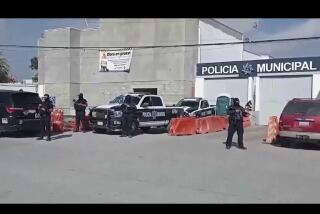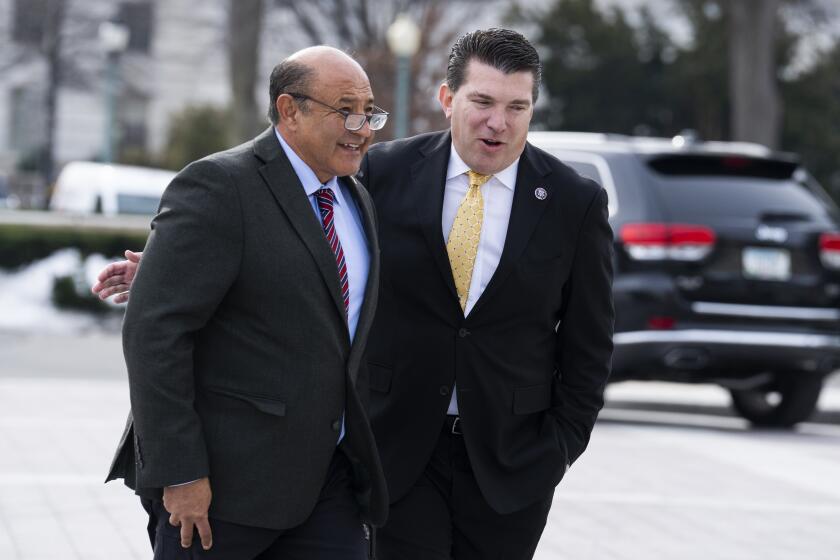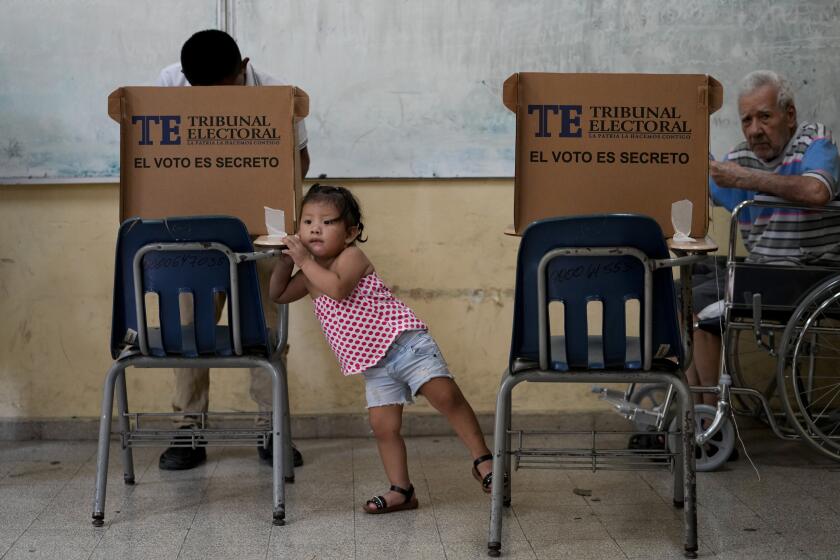Somali Warlords Agree to Arms Cut : Security: Dozens of gun-bearing vehicles are to be taken off the capital’s streets. If the threat to Marines is not removed, the vehicles will be destroyed.
Somalia’s two warring clan chiefs reached an agreement Monday to reduce the number of heavy weapons they have used to terrorize their country. The arms also were seen by American commanders here as a major obstacle to organizing relief shipments to this country’s worst famine areas.
The pact, brokered by the United States, came just a few hours after the first significant fight between Somalis and troops from the U.S.-led coalition force that came here 12 days ago.
It also followed serious criticism by relief agencies that a major section of Mogadishu was so dangerous that they had suspended efforts to distribute food and medical aid to starving Somalis there.
U.S. Marine Col. Michael Hagge, chief of operations for the American task force, Mohammed Farah Aidid and his chief clan rival, Ali Mahdi Mohamed, agreed in an afternoon meeting to remove from Mogadishu 30 to 40 heavily armed vehicles called “technicals.”
Described by Hagge as “a vehicle with a motor, four wheels with a big gun on it,” the technicals have been used to terrorize the population here. They also played a role in the civil war that has raged for two years. They often are little more than pickup trucks with anything from .50-caliber machine guns to rocket launchers to antiaircraft guns mounted on their roofs.
The technicals--a term also sometimes used to describe the armed Somalis who ride the vehicles--are the greatest threat to the U.S. Marines here, officials say, and there have been several firefights between them and American and French forces.
Under the accord, which Hagge called “a large step forward,” the two sides have two days to move the technicals out of the capital and into confinement zones. If they are moved otherwise, the colonel said, they will be destroyed by American and other coalition forces.
The two sides also agreed to reduce the number of other types of weapons in the city in an effort to ease the relief efforts and to try to restart business in this city where people have been afraid to open shops for fear of being robbed at gunpoint.
As for the security of the relief-assisting military forces here, their concern about technicals was heightened considerably when they were involved in a clash late Sunday night between Somalis and a French force protecting food distribution centers near the town of Baidoa. According to a French colonel, “this was a most sophisticated and serious attack.”
By his description, an outpost four miles south of the city was attacked by a technical armed with a large machine gun and carrying about 15 men. The colonel said some of the Somalis were equipped with night scopes that enabled them to see in the dark.
In classic guerrilla style, when the French called for reinforcements, the platoon sent to relieve the outpost was raked with automatic rifle fire by Somalis who had set up an ambush. In the end, the French, aided by rocket-firing Marine helicopter gunships, drove off their attackers. Three Somalis were wounded and captured; the technical was confiscated, and a large collection of AK-47 assault rifles and other weapons was recovered.
“This was not a minor incident,” the French colonel said. “This was well planned and a clear effort to test our ability to react.”
Added to this were several more minor incidents Monday, including one in which French forces, also south of Baidoa, were forced to a halt because of road mines. When they returned from clearing one mine, they found their vehicle surrounded by other mines placed while their backs were turned.
Beyond those actions, the most serious violence continues to take place along the Green Line, which separates Aidid’s forces in south Mogadishu from Mahdi’s gunmen in the north. Gunfire is constant, and confrontations with American troops are increasing. Unlike the southern part of the city, where Marines and French troops patrol, the 20% of the city north of the Green Line is under the control of the gunmen and their technicals.
The result is a violent chaos, in which journalists are under continuous assault and relief agencies besieged. The situation has grown so dangerous that GOAL, one of the largest private agencies distributing food in the area, has suspended all operations until the American troops enter the area and establish security.
Mark Thomas, a U.N. Children’s Fund spokesman, said his and other relief organizations have asked the Marines to secure the areas; they have received a “we’re looking at it” response, he said.
Hagge repeated to reporters what has been the official line since the troops came ashore Dec. 9: “When we have sufficient troop strength we will move. . . . As our own force builds up, we intend to expand . . . into all of Mogadishu.”
So far, only about 10,000 of the promised 30,000 coalition troops are on the ground. And even though the Aidid-Mahdi agreement covers the north, if the number of technicals to be removed is limited to 40, dozens more will remain in northern Mogadishu. Reporters counted 39 in one compound alone.
Since the two warlords also do not control the large number of just plain bandits and other clans, particularly in the area north of the capital, the situation remains volatile, so much so that Thomas said that UNICEF has tried to evacuate all of its staff from that section. Still, it has been unable to extricate some employees because it is too dangerous.
No relief has reached food centers in north Mogadishu in 10 days because of looting and threats.
Whether the Aidid-Mahdi agreement will ease the situation is problematic. A similar agreement worked out with American mediation the day after the initial U.S. Marine invasion here obviously failed. As one relief specialist said, “technicals that were moved out of town then are coming back in.”
Hagge acknowledged that there “always is the potential they can go back into action. . . . But we are confident they will stay there.”
Implicit throughout Hagge’s briefing was the threat that, if the Somali warlords fail to keep their word and do not reduce their arsenals, the Americans will do it for them; that is what the rank-and-file troops, who have been constantly harassed and shot at, are pushing for.
But, said Hagge, “we are not here to disarm anybody unless they threaten us. We are trying to get the factions under control so there won’t be the confrontations” that will lead to further American intervention.
There will, however, be a signal of the increasing American presence here Tuesday when 1,900 newly arrived members of the 7th Marine Regimental Combat Team head for Baidoa; from there, they will spread out into rural areas still under the control of warlords.
Also in the planning is the occupation of Bardera, located inland from the port of Kismayu in southern Somalia and considered the last major city still to be brought under the control of U.S.-led forces. Several renegade clans are thought to be in the Bardera area, and the roads to the city have been heavily mined. But Hagge said his forces can handle that, although he refused to discuss Bardera further.
In areas controlled by the Marines and their allies, relief shipments are picking up at an encouraging rate, relief officials said.
At least two air shipments a day are reaching Baidoa, Thomas said, bringing in about 200 tons of food. New distribution systems also are being set up to bypass previous relief channels in which most of the food was looted or appropriated by local leaders for their own use.
But air shipments are not enough, said David Kaatrud, an official with the World Food Program. “What we want,” he said, “is overland access to the interior where the starving are.”
BACKGROUND: THE ‘TECHNICALS’
Why are weapon-wielding Somali gangs and their odd, armed vehicles called “technicals”? Many theorize that it stems from the practices of foreign aid workers when submitting formal budgets to their superiors back home. They often employed one budget category--that for “technical assistance on the ground”--as a catchall; it sometimes, for example, was the account from which bribes were paid to corrupt local officials. Thus, in Somalia, the pay for “security” from ragtag gangs on unusual vehicles was described by some as “technical assistance.” That, in turn, may have been shortened to its now popularized form.
More to Read
Start your day right
Sign up for Essential California for news, features and recommendations from the L.A. Times and beyond in your inbox six days a week.
You may occasionally receive promotional content from the Los Angeles Times.






